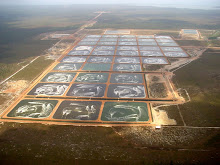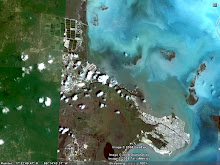

We set up four fish tanks with filters, goldfish, and pondwater. The objectives of our experiments are to test the capacity of various materials for growth, to be able to compare different harvesting methods, and to have a tangible model of algal growth on substrates to spark creativity.
Meanwhile, members of our innovation/brainstorm group were exploring a few different concepts. We toyed with the idea of creating a quick method to apply silicon to substrates before emersion in the water to promote more growth. This was inspired by a closer reading of the aquamat manual, where it is recommended that the mats be soaked in chemicals for several hours before introduction into the shrimp ponds. Polluting the canals with excess silicate was one concern.
Another concept we discussed at length was the option of open water harvesting. From looking at any pond we know that diatom growth occurs without special substrates, and there are preexisting methods of controlling these (pond vacuums, skimmers, and enzymes for your neighborhood catchment). We looked into different ways to blow algae to the top (like a centrofuge effect). Another option would be a substrate that sort of functions as a net, growing algae near the bottom of the pond and then, when ready to harvest, catching the free water algae as it is pulled to the surface of the water.
Many design ideas were thrown around, written down. Other group members meanwhile played with the CAD modeling software. Their main success was to get a running model of a capped pipe with water flowing through it, which will be helpful when we want to put our virtual prototype in canal conditions. Those managing our finances handled receipts, and communicators/researchers contacted people from the geological survey.
After about two weeks of growth, we took the substrates out to see what we had grown. With the help of the school’s biology teacher, Mr. Stone, we used a microscope to observe the filamentous algae, and then discussed designs with him. Having grown lots of aquarium algae, Mr. Stone helped us bring together some components of previous designs for a new system that we are currently working to design, test, and improve. If we were to target one meeting as a “breakthrough”, it would be the one that Mr. Stone attended. More details on the latest design to come when I can get some photos of our model to help describe it.
As part of the grant requirements we are working on five videos about the project. As we’re producing storyboards and organizing filming, we realised that footage from Belize would aid our videos immensely. So, if anyone is in the mood to take a couple shots of canals, shrimp, ponds, people… Video team would be eternally grateful!
*Inventor’s club’s new years resolution: better communication.









Wow! Progress indeed!
ReplyDeletePlease let me know (on the blog or through email) what kinds of objectives you have for the videos. I'll probably be around later in the month if we need to coordinate a hand off and I plan to be back in Belize by early February.